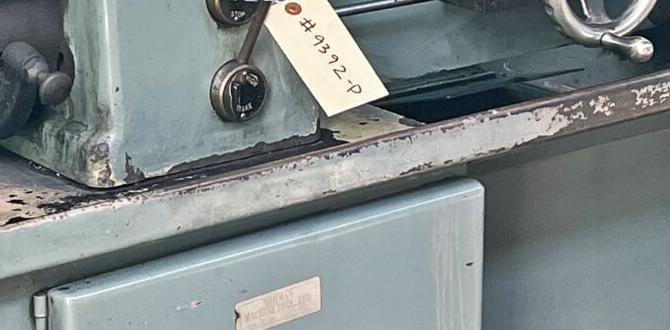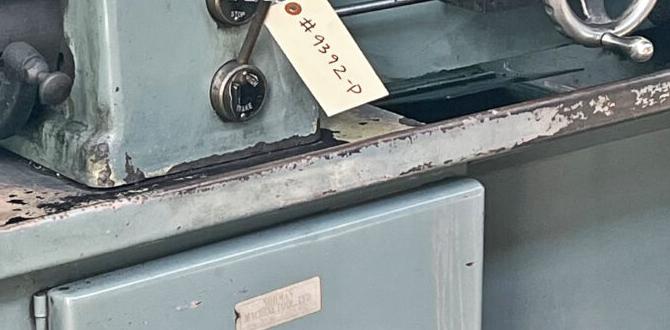Quick Summary: Discover essential mini wood lathe spindle projects perfect for beginners, transforming small wood pieces into beautiful, functional items like candle holders, rolling pins, and small decorative pieces. Learn fundamental turning techniques and create impressive results with your mini lathe.
Hey folks, Daniel Bates here from Lathe Hub! Feeling a bit intimidated by your mini wood lathe? You’ve got this fantastic machine, but maybe you’re not sure where to start. It’s totally normal to feel that way! Many beginners find themselves staring at a block of wood, wondering what they can actually make. The good news is, with just a little guidance, you can turn those small pieces of wood into something truly special. We’ll unlock the secrets to some genius mini wood lathe spindle projects that are perfect for getting your hands dirty and building your confidence. Get ready to create, learn, and have some serious fun in your workshop!
Why Mini Wood Lathe Spindle Projects Are Your Gateway to Turning
Mini wood lathe spindle projects are the absolute sweet spot for anyone new to the world of woodturning. Why? Because they focus on turning pieces where the diameter is significantly smaller than the length – think rods, dowels, and other elongated shapes. These projects are fantastic for a few key reasons:
- Manageable Material Size: Spindles use smaller pieces of wood, making them less intimidating and easier to handle on a mini lathe.
- Focus on Fundamental Techniques: They’re perfect for mastering basic cuts like the roughing cut, peeling cuts, beading, and parting off. These are the building blocks for almost everything you’ll turn.
- Quick Wins & Satisfaction: You can often complete a spindle project in a single session, giving you that immediate sense of accomplishment that keeps you motivated.
- Low Material Cost: Small scraps of wood are usually all you need, so you can experiment without breaking the bank.
- Versatile End Results: Even simple spindles can be turned into useful or decorative items, proving your skills right from the start.
Let’s dive into some of the most brilliant and beginner-friendly mini wood lathe spindle projects that will have you turning like a pro in no time!
Genius Mini Wood Lathe Spindle Projects for Beginners
When you’re starting out, the goal is to build confidence and practice essential skills. These spindle projects are designed to do just that. They’re simple in concept but allow for lots of room for creativity and skill development.
Project 1: The Simple Dowel or Rod
This is the absolute bedrock of spindle turning. It teaches you how to create a consistent diameter along a length of wood. Don’t underestimate its simplicity; mastering this is crucial.
What you’ll make: A straight cylinder of wood.
Skills practiced:
- Mounting wood between centers.
- Basic roughing cut.
- Using a skew chisel or gouge to create a cylinder.
- Using calipers to check diameter.
- Parting tool for cutting off.
Tools needed:
- Mini wood lathe
- Spur center and live center
- Face shield/safety glasses
- Dust mask
- Skew chisel or spindle gouge
- Parting tool
- Calipers
- Sandpaper (various grits)
Basic Steps:
- Prepare the Wood: Select a straight-grained piece of stock. Mount the spur center in one end and the live center in the other. Position the wooden workpiece between the lathe centers.
- Roughing: Turn on the lathe at a slow speed. Using your skew or gouge, begin removing the corners and roughing the wood down to a basic cylinder. Move across the bed, aiming for an even shape.
- Refining the Cylinder: Gradually refine the shape, making your cuts smoother. Aim for a consistent diameter. You can use calipers to check your measurements.
- Sanding: Once you have a smooth cylinder, sand it smoothly, working through progressively finer grits of sandpaper.
- Parting Off: Use the parting tool to cut the piece off the lathe, leaving a tenon on each end that will be removed.
Project 2: Candle Holders
Candle holders are fantastic because they involve shaping different diameters and often a recess for the candle. They can be as simple or complex as you like!
What you’ll make: A base with a stem, topped with a recess for a taper candle.
Skills practiced:
- Roughing and shaping.
- Creating different diameters.
- Using a drill bit to create a recess (using a tailstock chuck).
- Beading and coving cuts for decorative effects.
- Understanding balance and stability.
Tools needed:
- All tools from Project 1
- Tailstock chuck (drill chuck)
- Small drill bit (sized for a taper candle base, typically 7/8″ or 1″)
- Optional: Smaller gouges for decorative cuts
Basic Steps:
- Mount and Rough: Mount your wood between centers and rough it down to a basic shape that suggests your candle holder form.
- Shape the Base and Stem: Turn the base to be wider and stable. Then, turn the stem to your desired diameter and height.
- Create the Candle Socket: Move the tailstock close to the workpiece. Using a drill chuck in the tailstock, drill a hole for the candle. Start shallow and deepen it. You might need to re-center or move the tailstock back if you’re doing more shaping.
- Add Details: Use your gouge or skew to add decorative beads, coves, or curves to the base and stem. Sand smooth.
- Parting Off: Carefully part off the stem from the scrap wood, leaving a tenon to hold it while finishing.
Project 3: Rolling Pins
A rolling pin is a classic turned item that’s both functional and a great way to practice creating smooth, uniform surfaces perfect for food contact (with the right finish, of course).
What you’ll make: A smooth, cylindrical rolling pin, potentially with handles.
Skills practiced:
- Achieving a very smooth, uniform cylinder.
- Optional: Turning handles that integrate with the main pin.
- Understanding wood for food-safe applications.
Tools needed:
- All tools from Project 1
- Food-safe finish (mineral oil, beeswax blend)
- Consider a scroll chuck for the handles if you want them detachable
Basic Steps:
- Prepare Stock: Choose a dense hardwood like maple, cherry, or walnut for durability and food safety. Mount as usual.
- Rough and Shape: Turn the blank down to a cylinder. Focus on achieving a consistent diameter along the entire length.
- Smoothness is Key: This is where sanding comes in. Work through grits from 80 up to 320 or even 400. A well-sanded piece feels much better and takes finishes better.
- Optional Handles: If you’re making a rolling pin with fixed handles, you’ll turn them as part of the main spindle. If you plan for detachable handles (more advanced), you’d use a scroll chuck to attach them later. For beginners, integrated handles are simpler.
- Finishing: Once sanded smooth, apply a food-safe finish. Mineral oil is simple and effective. Check out resources like Woodworking Network for more on food-safe finishes.
Project 4: Small Decorative Spindles
These are for pure creative expression. Think small finials for furniture, decorative elements for boxes, or just practice turning interesting shapes.
What you’ll make: Small, often intricate spindle shapes with beads, coves, and tapers.
Skills practiced:
- Advanced use of skew and gouge for detailed cuts.
- Creating flowing curves and fine details.
- Developing an eye for proportion and design.
Tools needed:
- All tools from Project 1
- Smaller gouges (e.g., 1/4″ or 3/8″ spindle gouge)
- Detailer tools (optional but helpful)
Table: Common Decorative Cuts for Spindles
| Cut Type | Description | Tool Used | Beginner Tip |
|---|---|---|---|
| Bead | A convex curve, like half a circle. | Skew chisel or spindle gouge. | Start with shallow cuts. Aim for consistent depth. |
| Cove | A concave curve, like a small hollow. | Skew chisel or spindle gouge. | Use the tip of the tool and pivot. Practice on scrap. |
| Taper | A gradual decrease in diameter. | Skew chisel or gouge. | Make long, sweeping cuts rather than short, choppy ones. |
| Shoulder | A sharp, abrupt change in diameter. | Parting tool, or carefully with a skew. | Use the parting tool for clean shoulders. Practice precision. |
Basic Steps:
- Design: Sketch out your idea. Think about where your beads, coves, and tapers will go.
- Rough and Outline: Mount your wood and rough it down, then use the parting tool or a skew to mark out the major diameter changes and lengths.
- Shape Details: Begin making your decorative cuts. Work from larger sections to smaller details. Take light passes.
- Refine and Sand: Smooth out any tool marks. Sand carefully, especially around detailed areas.
- Part Off: Cut the finished spindle from the waste wood.
Project 5: Wooden Pegs or Dowel Pins
These are simple but very useful. You can turn them to exact sizes for specific projects.
What you’ll make: Small wooden pegs of consistent diameter and length.
Skills practiced:
- Precision turning to a specific diameter.
- Cutting to a consistent length.
- Mass production of small parts (if you make many).
Tools needed:
- All tools from Project 1
- Calipers
- Measuring tape or ruler
Basic Steps:
- Prepare Blank: Cut stock to multiples of your desired peg length plus a bit for parting. Mount between centers.
- Rough to Diameter: Use calipers to turn the entire length of the stock to your desired peg diameter.
- Mark and Part: Measure and mark your peg lengths. Use the parting tool to cut each peg off, leaving a small amount of waste between them. You’ll have a series of short spindles.
- Finish Each Peg: Once parted, you’ll have small tenons left on each peg. You can either remove these with a chuck and a sanding block or carefully shape them down with a skew.
Safety First: Your Golden Rule
Before we wrap up, let’s hammer home the most critical aspect of woodturning: safety. Your mini wood lathe is a powerful tool, and it demands respect. Always remember:
- Wear Safety Gear: This means a full face shield (not just safety glasses!), and a dust mask is essential for protecting your lungs from fine wood dust.
- Secure Your Workpiece: Ensure your wood is firmly mounted between centers and that it won’t catch or come loose.
- Tool Rest Placement: Properly position your tool rest close to the workpiece, but not touching it when the lathe is off. It should be about an eighth of an inch away.
- Sharp Tools: Dull tools are dangerous. They require more force, slip more easily, and produce ragged cuts. Keep your chisels and gouges sharp.
- Slow and Steady Revolutions: Start with slow speeds, especially when roughing or turning unbalanced pieces. As the wood becomes rounder and smoother, you can gradually increase the speed. A great resource for understanding lathe speeds is the Tooling.com Lathe Speed Calculator, which can help you find safe operating RPMs based on wood diameter and lathe type, though always err on the side of caution.
- Be Aware of Your Surroundings: Keep your workspace clean and free of clutter. No loose clothing, remove jewelry, and tie back long hair.
- Know Your Lathe: Read your lathe’s manual thoroughly. Understand its limitations and features.
Safety isn’t just a suggestion; it’s the foundation of enjoyable and productive woodworking. Make it a habit you never break.
Choosing Your Wood for Spindle Projects
The type of wood you choose can significantly impact your turning experience and the final look of your projects. For beginner spindle projects, it’s best to start with softer, easier-to-turn woods.
Recommended Woods for Beginners:
- Pine: Very soft and easy to cut, but can be prone to tear-out. Great for practicing.
- Basswood: Also very soft, but fine-grained and less prone to tear-out than pine.
- Poplar: A bit harder than pine or basswood, but still turns well and takes finishes nicely.
- Ash: A bit harder, with a nice grain that shows up well.
Woods to Consider as Skills Advance:
- Maple: Denser hardwood, excellent for items like rolling pins where durability is key. Can be harder to turn initially.
- Cherry: Beautiful color and grain, turns well.
- Walnut: Rich color, turns nicely once you’re comfortable with harder woods.
Important Note: Always use seasoned (dried) wood. Green wood is much harder to turn and can warp significantly as it dries. Commercial wood blanks are usually dried and ready to use.
Essential Tools for Mini Lathe Spindle Turning
While you can technically turn with just a couple of tools, having a basic set will make your life much easier and allow for more creative possibilities. Here are the absolute essentials for spindle turning on a mini lathe:
Woodturning Tools:
- Spindle Gouge (3/8″ or 1/2″): Your workhorse for most spindle turning. It’s designed for cutting into the wood and creating curves.
- Skew Chisel (1/2″ or 3/4″): Excellent for smoothing, creating beads, and slicing cuts. It requires a bit more finesse but is invaluable.
- Parting Tool: Crucial for cutting tenons, creating grooves, and separating your finished piece from the waste wood. A narrow parting tool (e.g., 1/8″ or 3/16″) is often best for mini lathes.
- Scraper (optional but helpful): A flat-edged tool used to flatten surfaces or remove tool marks left by gouges.
Setup and Measuring Tools:
- Lathe Centers:





